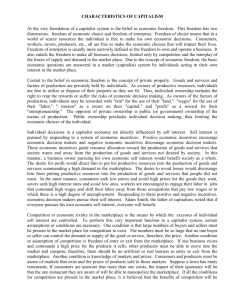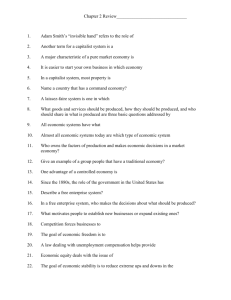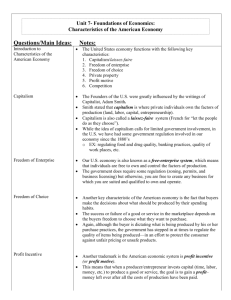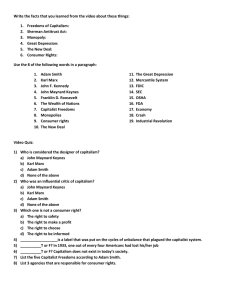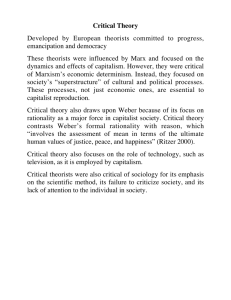CHARACTERISTICS OF CAPITALISM
advertisement
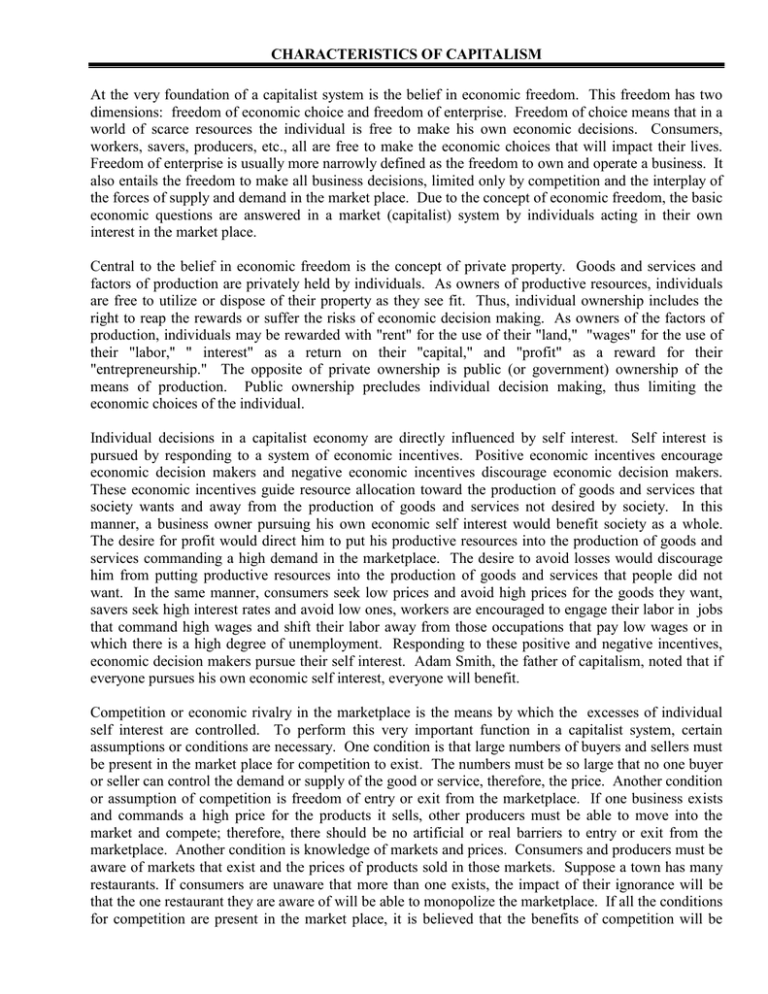
CHARACTERISTICS OF CAPITALISM At the very foundation of a capitalist system is the belief in economic freedom. This freedom has two dimensions: freedom of economic choice and freedom of enterprise. Freedom of choice means that in a world of scarce resources the individual is free to make his own economic decisions. Consumers, workers, savers, producers, etc., all are free to make the economic choices that will impact their lives. Freedom of enterprise is usually more narrowly defined as the freedom to own and operate a business. It also entails the freedom to make all business decisions, limited only by competition and the interplay of the forces of supply and demand in the market place. Due to the concept of economic freedom, the basic economic questions are answered in a market (capitalist) system by individuals acting in their own interest in the market place. Central to the belief in economic freedom is the concept of private property. Goods and services and factors of production are privately held by individuals. As owners of productive resources, individuals are free to utilize or dispose of their property as they see fit. Thus, individual ownership includes the right to reap the rewards or suffer the risks of economic decision making. As owners of the factors of production, individuals may be rewarded with "rent" for the use of their "land," "wages" for the use of their "labor,'' " interest" as a return on their "capital," and "profit" as a reward for their "entrepreneurship." The opposite of private ownership is public (or government) ownership of the means of production. Public ownership precludes individual decision making, thus limiting the economic choices of the individual. Individual decisions in a capitalist economy are directly influenced by self interest. Self interest is pursued by responding to a system of economic incentives. Positive economic incentives encourage economic decision makers and negative economic incentives discourage economic decision makers. These economic incentives guide resource allocation toward the production of goods and services that society wants and away from the production of goods and services not desired by society. In this manner, a business owner pursuing his own economic self interest would benefit society as a whole. The desire for profit would direct him to put his productive resources into the production of goods and services commanding a high demand in the marketplace. The desire to avoid losses would discourage him from putting productive resources into the production of goods and services that people did not want. In the same manner, consumers seek low prices and avoid high prices for the goods they want, savers seek high interest rates and avoid low ones, workers are encouraged to engage their labor in jobs that command high wages and shift their labor away from those occupations that pay low wages or in which there is a high degree of unemployment. Responding to these positive and negative incentives, economic decision makers pursue their self interest. Adam Smith, the father of capitalism, noted that if everyone pursues his own economic self interest, everyone will benefit. Competition or economic rivalry in the marketplace is the means by which the excesses of individual self interest are controlled. To perform this very important function in a capitalist system, certain assumptions or conditions are necessary. One condition is that large numbers of buyers and sellers must be present in the market place for competition to exist. The numbers must be so large that no one buyer or seller can control the demand or supply of the good or service, therefore, the price. Another condition or assumption of competition is freedom of entry or exit from the marketplace. If one business exists and commands a high price for the products it sells, other producers must be able to move into the market and compete; therefore, there should be no artificial or real barriers to entry or exit from the marketplace. Another condition is knowledge of markets and prices. Consumers and producers must be aware of markets that exist and the prices of products sold in those markets. Suppose a town has many restaurants. If consumers are unaware that more than one exists, the impact of their ignorance will be that the one restaurant they are aware of will be able to monopolize the marketplace. If all the conditions for competition are present in the market place, it is believed that the benefits of competition will be lower prices, greater variety, and better quality. These are benefits desired by all consumers in the marketplace. The desires of buyers and sellers are communicated in the market place through a price system. Buyers communicate the quantities of a good, service, or resource they are willing and able to purchase at various prices, and suppliers communicate the quantities of those items they are willing and able to sell at various prices. The interaction of the buyers and sellers results in a market price. Adam Smith believed that the market place acted as an "invisible hand" operating to balance the desires of both buyers and sellers and establish a price both could agree upon. The prices determined in the market place assist in determining the answers to the "what," "how," and "for whom" questions. If all the other characteristics are in place, capitalist (market) theory advocates a limited (laissez-faire) role for government in the economy. Government is to make and enforce the rules (laws) and settle disputes that arise between economic players. Its role is to establish a legal framework for the economic system to operate in, rather than to play a role in making economic decisions. Adam Smith believed that government intervention in the market place would interfere with the "invisible hand" and prevent the system from operating efficiently; therefore, he advocated a "laissez-faire" economic policy for government. Questions for discussion: 1. 2. 3. 4. 5. 6. 7. Identify and explain the six characteristics of capitalism. Of the six characteristics of capitalism, identify the ones that can be appropriately labeled the coordinating mechanism, the regulating mechanism, the guiding mechanism, and identify the three that are cornerstones of the system. Justify your choices. (Students should note that the regulating mechanism in a capitalist economy is not the role of government!). Distinguish between positive and negative economic incentives and their role in resource allocation. Give an example of each. Identify the "returns" or "rewards" for the factors of production. Identify the conditions required for competition to exist in the market place. What are the benefits of a competitive market? Identify Adam Smith. Although the U.S. economy is based on capitalist theory, it is in reality a "mixed economy." Which one of the above characteristics of capitalism is least likely adhered to in the U.S. economic system. Identify examples of how the U.S. economic system departs from capitalist theory in respect to each characteristic. Note how the characteristic that is least likely adhered to impacts all of the other characteristics.
